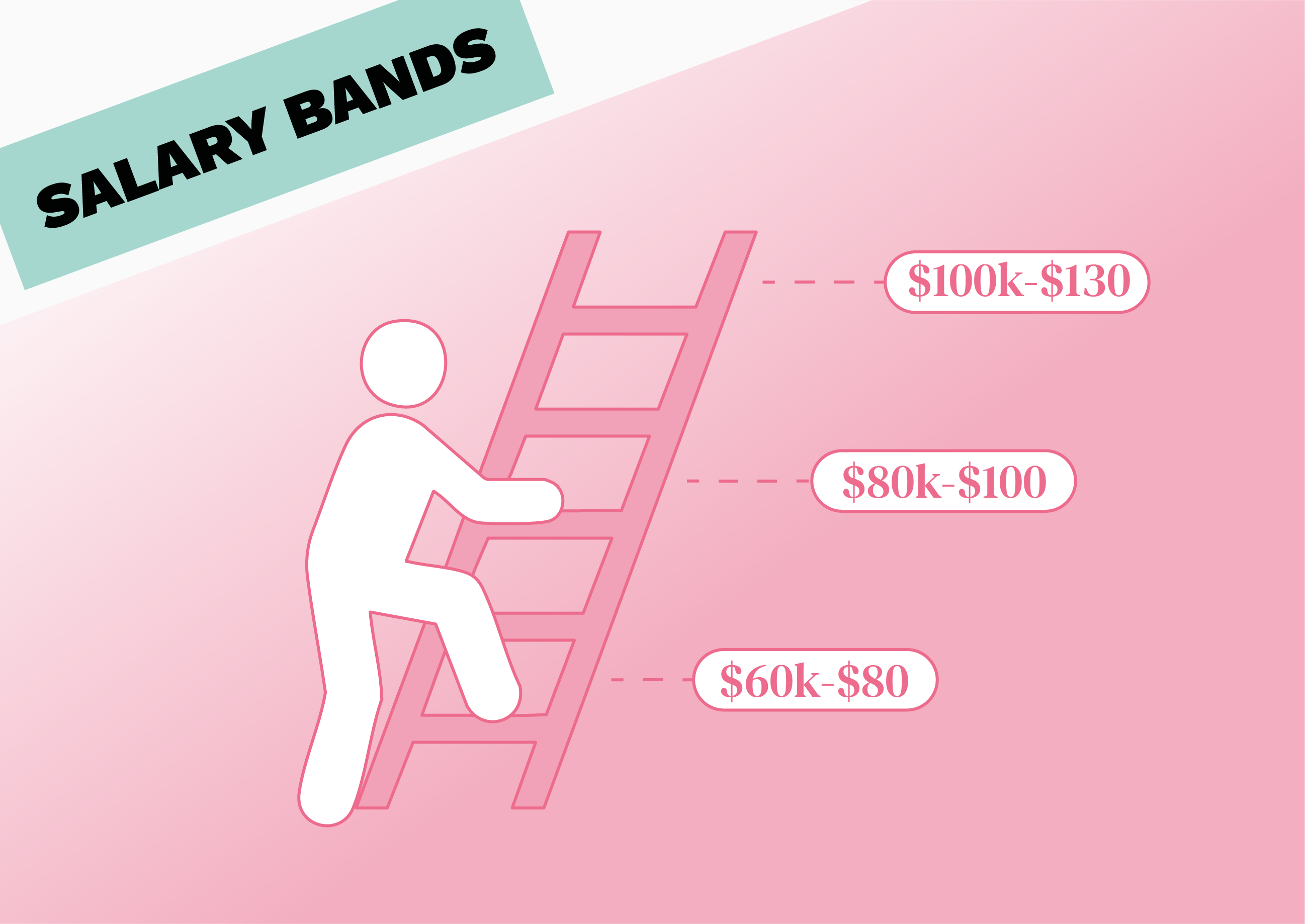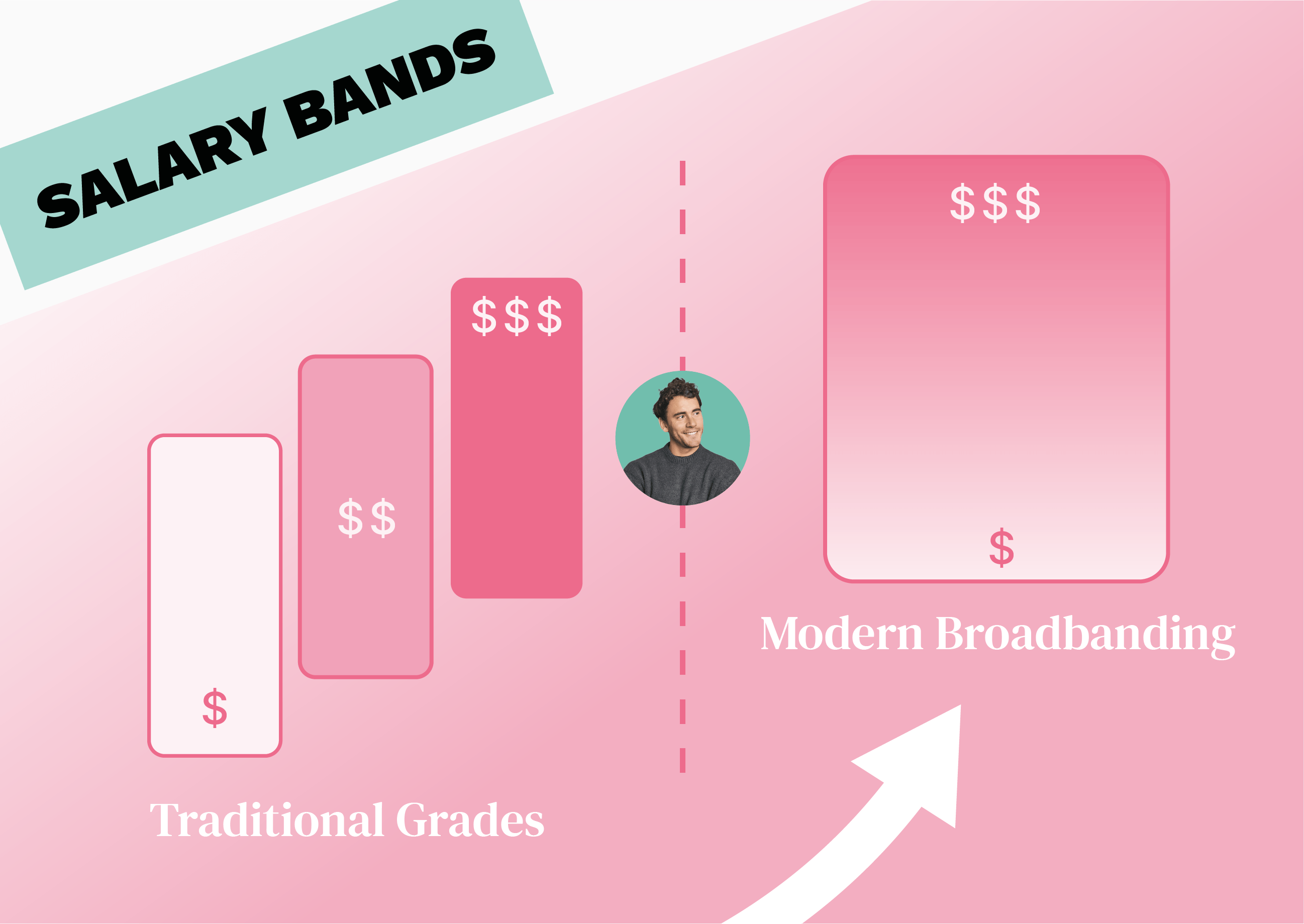What are the advantages and disadvantages of using salary bands
With the EU Directive on Pay Transparency just around the corner, there’s a lot of pressure on companies to ensure their pay policies are equitable and fair.
But even if your intentions are good, how can you be sure that every employee in your organisation is being paid exactly what they deserve according to their role, seniority and performance?
There’s more than one answer to this, of course. But here’s a solution we’re particularly fond of here at Figures: using salary bands.
Salary bands provide a clear, transparent framework for setting fair, equitable salaries. But, like any new pay strategy, setting up salary bands is a lot of work — and it’s important to be sure it’s the right strategy for you before diving in.
Read on for our full guide to the advantages and disadvantages of salary bands.
7 advantages of salary bands
Building salary bands for your organisation is a huge and time-consuming task. But is it worth it? We think so! Here are some of the many reasons why using salary bands is a good idea.
1. Helps ensure equitable pay
The pressure is on for companies to deliver equitable pay. Not just because of legislation like the upcoming EU Directive, but also because today’s employees are demanding it. In fact, a Gartner survey from 2022 found that employees who perceived their pay as inequitable were 15% less likely to stay with their employer, and 13% less engaged at work.
So, how do salary bands contribute to equitable pay? Simple: they ensure that everyone is paid according to a predefined set of criteria — not on the whim of whatever manager is making the decision.
Without clearly defined salary bands, salary decisions are often made on an ad-hoc basis by individual leaders — which can lead to inequity and unfairness. And this isn’t just a theory: our research shows that forward-thinking companies that use salary bands find it easier to make equal pay a reality.
2. Helps you attract top talent
Did you know that 44% of candidates have decided not to apply for a role because the job description didn’t include a salary? That means you could be losing almost half of your potential candidates if you’re not telling them what you’re willing to pay.
Including a salary band with your job description gives potential new hires a clear idea of your budget. That means two things: first, you won’t waste time with candidates who expect a higher salary than you can afford. And second, you won’t lose those candidates who are within your budget, but who might have been put off from applying if you’d simply talked about your “competitive salary” instead of being specific.
3. Provides a clear framework for progression
A salary band structure is a clear framework that shows employees exactly where they sit in your organisation’s hierarchy, and how they can grow within it. That means that not only do salary bands make it easier to attract top talent, they can also help you to retain and engage the staff you already have.
Salary bands also make pay reviews a much simpler process for managers and HR, because there’s a clear framework that underpins every decision.
4. Promotes transparency and fairness
Pay transparency has become a bit of a buzzword in HR. But it’s no good just talking about it if your company doesn’t have a strong compensation strategy that truly promotes it from the top down.
Using salary bands to create a transparent compensation framework shows employees that they’re being paid fairly. And, with the EU Pay Transparency Directive set to come into force in 2024, this is no longer just a nice-to-have.
Under this legislation, companies will have to provide information about salary to both employees and job seekers — or face penalties. Setting up a fair, transparent salary structure now is a great way to get ahead of things.
5. Reduces the possibility for bias
As we’ve mentioned, when you don’t have a clear salary structure in place, pay decisions are often made by individual managers on an ad-hoc basis. And one manager’s approach to setting salaries might look very different from another’s.
In fact, without the structure salary bands provide, there’s a lot of room for unconscious bias. Think this isn’t a problem in your organisation? Think again. It’s called unconscious bias for a reason, and unfortunately, we all have it.
However, that’s not to say that we can’t work to ensure it doesn’t impact our pay decisions. And setting up salary bands is a good place to start.
6. Makes it easier to plan your budget
It’s no secret that many companies are under pressure to do more with less. HR and compensation leaders need to balance rewarding employees for a job well done with sticking within the budget they have available.
Here’s the good news: using salary bands can help make budget planning more straightforward and reliable. For example, it’s easy to understand how hiring decisions will impact your overall spending, because the salary band for each role tells you the maximum you’ll pay for a new recruit.
7. Simplifies administration and communication
Companies without a structured salary band system in place often find that their salaries are… all over the place. Each team might have employees on multiple different levels, even when some of them are effectively doing the same work.
Even setting aside the potential for unfairness, this is a lot to manage. Salary bands lessen this administrative burden, simply because there are fewer levels and pay ranges to keep track of.
Plus, salary bands can also simplify communication around pay: instead of having to go to great lengths to justify each pay decision to employees, managers can simply point to the clearly set-out framework by way of explanation.
3 disadvantages of salary bands
At this point, you’d be forgiven for thinking that salary bands were the perfect solution for every organisation. But there are two sides to every story, and salary bands do come with certain downsides too.
Here are some of the disadvantages of salary bands that you should know about.
1. Increased administrative burden
Wait — didn’t we just say that salary bands could reduce the administrative burden on your HR and compensation team? Well, yes — in the long term. But there’s no denying that setting up salary bands is a big job.
To begin with, your HR team will need to decide what bands they want to create, and in what detail. They’ll also need to create a levelling framework that helps structure each salary band.
And of course, you’ll need to complete your salary grid with accurate, real-time data to ensure your salaries are in line with the market. You’ll then need to regularly reevaluate your salary bands — and by that we mean at least once a year, if not more.
If that all sounds a bit much right now, don’t worry — but do keep reading to the end to find out how Figures can make all of this a bit easier.
2. Need to complete pay reviews
It’s no good setting up a complex salary band system for new hires if you’re not going to adjust your existing salaries. All this will do is create resentment among your current employees — especially if they feel they’re not being paid at the market rate.
That means that, once you’ve built your salary bands, you should evaluate whether your existing salaries are aligned. It’s very possible that you’ll spot some gaps and need to make compensation adjustments — that’s why you’re going to all this effort in the first place, after all!
Of course, these adjustments might impact your budget — but that’s all part of the process of building a fair and equitable compensation structure.
3. Limits flexibility
For certain companies, salary bands can add an unnecessary rigidity, which can be a hindrance in the recruitment and attraction process.
For example, companies in high-tech industries or those seeking in-demand talent might find that market salaries are moving upwards at a faster rate than most companies update their salary bands. That means that, if you built your salary bands 11 months ago, you might miss out on a top candidate today simply because the market has changed.
The solution to this is fairly simple, although it does require more work: update your salary bands more frequently, and base them on market data that’s as close to real-time as you can get.
So, is creating salary bands worth it?
As we’ve discussed, salary bands promote pay equity, drive transparency and attract top talent. But it does take time to transition to this new system — which puts a lot of HR and compensation leaders off from taking the plunge.
Listen, we’re not going to sit on the fence and pretend we’re not big fans of salary bands. We are — that’s why we’ve created Figures Salary Bands so that every company can build a fair, structured compensation strategy, without the headache.
Using our salary band tool, you can easily create a customisable and flexible salary grid that’s in line with your organisation’s compensation philosophy, in a fraction of the time. You can tailor your ranges to the market position you’re aiming for, and adjust the width and overlap of your bands however you like.
Put simply, Figures makes it easy to create a single source of truth for all salary decisions — giving your employees the fair and equitable pay structure they deserve.
Want to learn more? Book your free demo to get started.
.avif)




